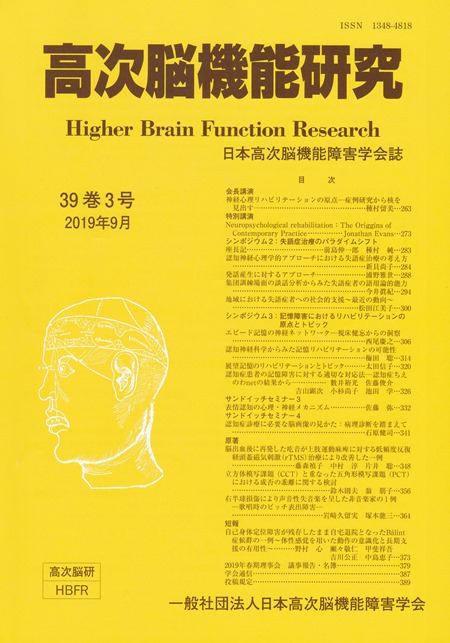Volume 39, Issue 3
Displaying 1-17 of 17 articles from this issue
- |<
- <
- 1
- >
- >|
President's lecture
-
2019 Volume 39 Issue 3 Pages 263-272
Published: September 30, 2019
Released on J-STAGE: October 01, 2020
Download PDF (744K)
Special lecture
-
2019 Volume 39 Issue 3 Pages 273-282
Published: September 30, 2019
Released on J-STAGE: October 01, 2020
Download PDF (142K)
Symposium 2 : Paradigm Shift in speech therapy for aphasic patients
-
2019 Volume 39 Issue 3 Pages 283
Published: September 30, 2019
Released on J-STAGE: October 01, 2020
Download PDF (152K) -
2019 Volume 39 Issue 3 Pages 284-287
Published: September 30, 2019
Released on J-STAGE: October 01, 2020
Download PDF (300K) -
2019 Volume 39 Issue 3 Pages 288-293
Published: September 30, 2019
Released on J-STAGE: October 01, 2020
Download PDF (731K) -
2019 Volume 39 Issue 3 Pages 294-299
Published: September 30, 2019
Released on J-STAGE: October 01, 2020
Download PDF (499K) -
2019 Volume 39 Issue 3 Pages 300-305
Published: September 30, 2019
Released on J-STAGE: October 01, 2020
Download PDF (647K)
Symposium 3 : Rehabilitation for memory deficits
-
2019 Volume 39 Issue 3 Pages 306-313
Published: September 30, 2019
Released on J-STAGE: October 01, 2020
Download PDF (605K) -
2019 Volume 39 Issue 3 Pages 314-319
Published: September 30, 2019
Released on J-STAGE: October 01, 2020
Download PDF (370K) -
2019 Volume 39 Issue 3 Pages 320-325
Published: September 30, 2019
Released on J-STAGE: October 01, 2020
Download PDF (341K) -
2019 Volume 39 Issue 3 Pages 326-331
Published: September 30, 2019
Released on J-STAGE: October 01, 2020
Download PDF (428K)
Seminar with Sandwich 3
-
2019 Volume 39 Issue 3 Pages 332-340
Published: September 30, 2019
Released on J-STAGE: October 01, 2020
Download PDF (582K)
Seminar with Sandwich 4
-
2019 Volume 39 Issue 3 Pages 341-347
Published: September 30, 2019
Released on J-STAGE: October 01, 2020
Download PDF (1061K)
Original article
-
2019 Volume 39 Issue 3 Pages 348-355
Published: September 30, 2019
Released on J-STAGE: October 01, 2020
Download PDF (587K) -
2019 Volume 39 Issue 3 Pages 356-363
Published: September 30, 2019
Released on J-STAGE: October 01, 2020
Download PDF (445K) -
2019 Volume 39 Issue 3 Pages 364-372
Published: September 30, 2019
Released on J-STAGE: October 01, 2020
Download PDF (2710K)
Brief report
-
2019 Volume 39 Issue 3 Pages 373-378
Published: September 30, 2019
Released on J-STAGE: October 01, 2020
Download PDF (756K)
- |<
- <
- 1
- >
- >|
